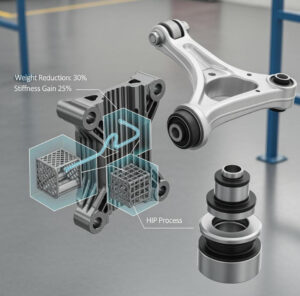3D-printat metallpulver lämpligt för MIM Technology
Innehållsförteckning
Föreställ dig att du tillverkar komplicerade metallkomponenter med hög precision och komplexa geometrier - allt tack vare en revolutionerande 3D-utskriftsteknik. Det är det magiska med formsprutning av metall (MIM), och den hemliga ingrediensen? Specialiserade metallpulver som blåser liv i dessa miniatyrunderverk. Spänn fast dig, för vi dyker djupt in i världen av MIM-kompatibla metallpulver och utforskar deras egenskaper, populära val och de faktorer som gör att de fungerar.
egenskaper hos 3D-printat metallpulver som lämpar sig för MIM
- Fin partikelstorlek: Tänk dig en strand som är full av stenar jämfört med en strand som är beströdd med fin sand. På samma sätt trivs MIM med metallpulver med en liten partikelstorlek, vanligtvis mellan 5 och 20 mikrometer. Detta möjliggör ett exceptionellt flöde under formsprutningen, vilket säkerställer att invecklade detaljer replikeras felfritt i den slutliga delen.
- Hög sfäriskhet: Föreställ dig perfekt runda kulor jämfört med ojämna stenar. Sfäriska partiklar i metallpulver har överlägsen packningstäthet, vilket leder till en mer enhetlig struktur och förbättrade mekaniska egenskaper i den färdiga produkten.
- Utmärkt flytbarhet: Tänk på hällande mjöl kontra tjock havregrynsgröt. MIM-pulver behöver exceptionell flytbarhet för att kunna navigera i de invecklade kanalerna i formhålan under insprutningen. Detta leder till en smidig gjutningsprocess och minimerar risken för defekter.
- Låg syrehalt: Syre kan vara en festförstörare i MIM-världen. Alltför höga syrenivåer hindrar sintring, ett avgörande steg där metallpartiklarna smälter samman, vilket försämrar den slutliga komponentens styrka och densitet.
Här är en praktisk tabell som sammanfattar de viktigaste egenskaperna hos MIM-klara metallpulver:
| Karaktäristisk | Betydelse |
|---|---|
| Fin partikelstorlek (5-20 mikrometer) | Möjliggör invecklade detaljer och smidigt flöde |
| Hög sfäriskhet | Förbättrar packningstätheten och de mekaniska egenskaperna |
| Utmärkt flytbarhet | Säkerställer smidig formsprutning och minimerar defekter |
| Låg syrehalt | Främjar effektiv sintring och optimal hållfasthet |
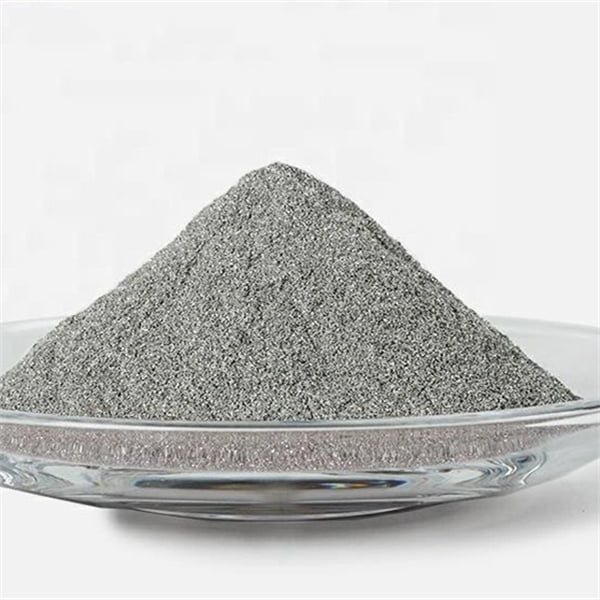
Vanligt förekommande MIM Teknik 3D-utskrift av metallpulver
Nu när vi har förstått de ideala egenskaperna, låt oss utforska några av de mest populära metallpulver som används i MIM-teknik:
1. Rostfritt stål 316L:
- Ett austenitiskt rostfritt stål som är känt för sin utmärkta korrosionsbeständighet, vilket gör det till en mästare i applikationer som utsätts för tuffa miljöer som marina komponenter, medicinska implantat och kemisk processutrustning.
- Jämfört med sin kusin, 17-4PH rostfritt stål, erbjuder 316L överlägsen korrosionsbeständighet men kan vara något svagare när det gäller råstyrka.
2. 17-4PH rostfritt stål:
- Detta utskiljningshärdande rostfria stål har exceptionell styrka och hårdhet och är idealiskt för delar som kräver hög slitstyrka, t.ex. kugghjul, kammar och fästelement.
- I jämförelse med 316L har 17-4PH en hög hållfasthet men kan vara mindre lämplig för starkt korrosiva miljöer. Efterbehandlingstekniker kan dock förbättra dess korrosionsbeständighet i viss utsträckning.
3. Låglegerat stål:
- Ett kostnadseffektivt alternativ för icke-kritiska applikationer där hög hållfasthet inte är av största vikt.
- Jämfört med alternativ i rostfritt stål kan låglegerat stål uppvisa lägre korrosionsbeständighet, vilket gör det mindre lämpligt för krävande miljöer. Det är dock mycket prisvärt, vilket gör det till ett populärt val för högvolymsproduktion av enkla komponenter.
4. Nickellegeringar:
- Nickellegeringar erbjuder exceptionell styrka, hög temperaturbeständighet och utmärkt korrosionsbeständighet mot tuffa kemikalier och är det självklara valet för krävande applikationer inom flyg-, olje- och gasindustrin samt kemisk processindustri.
- Nickellegeringar har överlägsen prestanda, men har ett högre pris jämfört med andra alternativ.
5. Verktygsstål:
- Verktygsstål är konstruerat för exceptionell slitstyrka och dimensionsstabilitet och blir hjälten i applikationer som formar, matriser och skärverktyg.
- Jämfört med andra alternativ kan verktygsstål kräva specifika efterbearbetningstekniker för att uppnå önskade egenskaper, vilket ökar produktionskomplexiteten.
6. Kopparlegeringar:
- Koppar, som är känt för sin utmärkta termiska och elektriska ledningsförmåga, hittar sin nisch i applikationer som kräver effektiv värmeavledning och elektrisk ledning, t.ex. kylflänsar och elektriska kontakter.
- Ren koppar kan dock sakna den mekaniska hållfasthet som krävs för vissa tillämpningar. Genom att legera koppar med element som tenn eller krom kan man förbättra hållfastheten samtidigt som man behåller fördelarna med ledningsförmågan.
7. Titanlegeringar:
- Dessa lätta men ändå otroligt starka legeringar är superstjärnor inom flyg- och rymdindustrin och biomedicinska tillämpningar där viktreduktion och biokompatibilitet är av största vikt.
- Titanlegeringar erbjuder exceptionella prestanda, men har en hög prislapp på grund av den komplexa tillverkningsprocessen och de höga råvarukostnaderna.
8. Kovar:
- En legering med kontrollerad expansion som är känd för sin förmåga att matcha glasets värmeutvidgningskoefficient, vilket gör den till den perfekta partnern för tätning av glas mot metallkomponenter i elektronik och vetenskapliga instrument.
- Jämfört med andra alternativ kan Kovar uppvisa lägre mekanisk hållfasthet, så det passar bäst för applikationer där strukturell integritet inte är ett primärt problem.
9. Inconel:
- En familj av superlegeringar som är kända för sin exceptionella högtemperaturhållfasthet, oxidationsbeständighet och krypbeständighet. Dessa egenskaper gör Inconel idealiskt för komponenter med heta sektioner i jetmotorer, gasturbiner och andra högtemperaturtillämpningar.
- I likhet med nickellegeringar har Inconel en högre kostnad på grund av sin komplexa sammansättning och krävande tillverkningsprocess.
10. Volframkarbid:
- Detta otroligt hårda och slitstarka material hittar sin nisch i applikationer som kräver exceptionell nötningsbeständighet, t.ex. skärverktyg, slitkuddar och munstycken.
- Volframkarbid kan dock vara sprött och känsligt för flisning under vissa förhållanden. Noggrann design och noggrant urval är avgörande för en lyckad implementering.
Här är en tabell som sammanfattar dessa vanligt förekommande MIM-metallpulver:
| Metallpulver | Fastigheter | Typiska tillämpningar |
|---|---|---|
| Rostfritt stål 316L | Utmärkt korrosionsbeständighet, god formbarhet | Marina komponenter, medicinska implantat, utrustning för kemisk bearbetning |
| 17-4PH rostfritt stål | Hög hållfasthet, hårdhet och slitstyrka | Kugghjul, kammar, fästelement |
| Låglegerat stål | Kostnadseffektiv, bra för icke-kritiska applikationer | Enkla komponenter, produktion i stora volymer |
| Nickellegeringar | Exceptionell styrka, hög temperaturbeständighet, utmärkt korrosionsbeständighet | Flyg, olja & gas, kemisk bearbetning |
| Verktygsstål | Exceptionell slitstyrka, dimensionsstabilitet | Gjutformar, matriser, skärverktyg |
| Kopparlegeringar | Utmärkt termisk och elektrisk ledningsförmåga | Kylflänsar, elektriska anslutningar |
| Titanlegeringar | Lättvikt, hög hållfasthet, biokompatibel | Flyg- och rymdindustrin, biomedicinska tillämpningar |
| Kovar | Kontrollerad termisk expansionskoefficient | Försegling av glas mot metallkomponenter |
| Inconel | Hållfasthet vid höga temperaturer, oxidations- och krypningsbeständighet | Jetmotorer, gasturbiner |
| Volframkarbid | Exceptionell hårdhet, slitstyrka | Skärverktyg, slitkuddar, munstycken |
Ytterligare överväganden vid val av MIM Metallpulver:
Utöver kärnegenskaperna finns det flera andra faktorer som påverkar valet av MIM-metallpulver:
- Tillgänglighet: Vissa exotiska metallpulver kan ha begränsad tillgänglighet eller längre ledtider, vilket påverkar produktionsscheman.
- Kostnad: Priserna kan variera avsevärt beroende på material, tillverkningens komplexitet och efterfrågan på marknaden.
- Miljöbestämmelser: Vissa beståndsdelar i metallpulver kan omfattas av strängare regler för bortskaffande eller hantering.
Specifikationer, storlekar och kvaliteter
Låt oss gå djupare och utforska några tekniska specifikationer för MIM-metallpulver:
| Karaktäristisk | Beskrivning | Exempel |
|---|---|---|
| Fördelning av partikelstorlek | Variationen av partikelstorlekar i pulvret | Kan variera från 5-20 mikron, med en tät fördelning för optimalt flöde |
| Skenbar densitet | Pulverets vikt per volymenhet i löst, okompakterat tillstånd | Vanligtvis uttryckt i g/cm³ |
| Tappdensitet | Pulvrets densitet efter en standardiserad tappningsrutin | Ofta högre än skenbar densitet på grund av förbättrad packning |
| Flödeshastighet | Den hastighet med vilken pulver flyter under specifika förhållanden | Mäts i sekunder/gram |
| Fukthalt | Mängden fukt som finns i pulvret | Hålls helst låg för att förhindra bearbetningsproblem |
| Syrehalt | Mängden syre som finns i pulvret | Lägre syrehalt ger bättre sintring |
Dessa specifikationer dokumenteras vanligtvis av pulverleverantören och kan variera beroende på det specifika materialet och kvaliteten. Dessutom finns MIM-pulver ofta i olika kvaliteter, var och en anpassad till specifika prestandakrav.
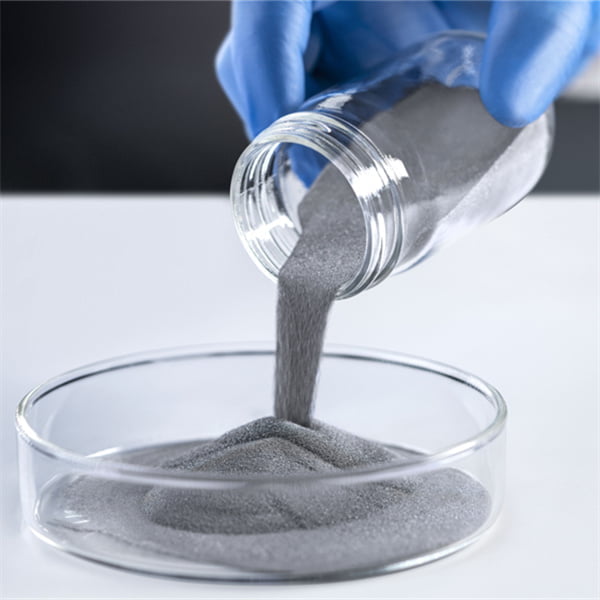
Utforska MIM Leverantörer av metallpulver
Landskapet av leverantörer av MIM-metallpulver är varierat, med flera etablerade aktörer som erbjuder en rad olika material och kvaliteter. Här är en inblick i några framstående namn:
- Höganäs AB: En ledande global producent av metallpulver som erbjuder ett brett urval av MIM-färdiga pulver i olika material.
- AMEX Additive GmbH: Specialiserat på högpresterande metallpulver för additiv tillverkning, inklusive MIM.
- Snickeri Additiv Pulver Produkter: Ett dotterbolag till Carpenter Technology Corporation, som tillhandahåller MIM-pulver för applikationer som kräver överlägsna mekaniska egenskaper.
- Sandvik Additiv tillverkning: Utnyttjar Sandviks expertis inom metallurgi för att erbjuda MIM-pulver med exceptionell kvalitet och jämnhet.
Överväganden om prissättning: Avslöja kostnadsfaktorn
Kostnaden för MIM-metallpulver kan variera avsevärt beroende på flera faktorer:
- Material: Exotiska material som titan eller Inconel tenderar att vara dyrare än vanliga alternativ som rostfritt stål.
- Pulver Egenskaper: Fin partikelstorlek, hög sfäriskhet och snäv partikelstorleksfördelning är ofta dyrare på grund av komplexiteten i tillverkningen av sådana pulver.
- Volym: Bulkköp omfattas vanligtvis av rabatterade priser jämfört med mindre beställningar.
- Leverantör: Olika leverantörer kan ha varierande prisstrukturer baserat på deras produktionskostnader och marknadspositionering.
Även om specifik prisinformation kanske inte är lättillgänglig på grund av fluktuerande marknadsförhållanden och individuella leverantörsförhandlingar, kan man med säkerhet säga att MIM-metallpulver kan variera från några dollar per kilo för vanliga material som låglegerat stål till hundratals dollar per kilo för högpresterande alternativ som Inconel eller titanlegeringar.
Fördelar och begränsningar med MIM-metallpulver
MIM-metallpulver erbjuder en unik kombination av fördelar och begränsningar. Låt oss titta närmare på båda sidorna av myntet:
Fördelar med MIM-metallpulver:
- Designfrihet: MIM gör det möjligt att skapa komplexa geometrier med invecklade detaljer som är omöjliga att åstadkomma med traditionella bearbetningstekniker.
- Hög precision: MIM producerar komponenter som är nära nätformade med snäva dimensionstoleranser, vilket minimerar behovet av omfattande efterbearbetning.
- Massproduktion: MIM möjliggör kostnadseffektiv massproduktion av små, komplicerade metalldelar.
- Materialets mångsidighet: Ett brett utbud av metallpulver finns tillgängligt för att tillgodose olika applikationsbehov.
- Minskning av avfall: MIM använder en process som är nära nätformen, vilket minimerar materialspillet jämfört med traditionella bearbetningsmetoder.
Begränsningar för MIM-metallpulver:
- Begränsningar av delstorleken: MIM är vanligtvis lämpat för mindre komponenter på grund av begränsningar i formfyllningskapaciteten.
- Materialegenskaper: MIM-tillverkade detaljer kanske inte alltid uppnår samma mekaniska egenskaper som de som tillverkas med traditionella metoder som smide eller maskinbearbetning, särskilt när det gäller högpresterande material.
- Ytfinish: MIM-delar kan kräva ytterligare efterbehandlingssteg för att uppnå önskad ytfinish.
- Designöverväganden: Att konstruera för MIM kräver noggrann uppmärksamhet på detaljgeometri och detaljstorlek för att säkerställa framgångsrik produktion.
- Kostnad: Även om MIM-pulver är kostnadseffektiva för massproduktion kan de i sig vara dyra, särskilt när det gäller exotiska material.
MIM Metallpulver: En blick in i framtiden
Framtiden för MIM-metallpulver är full av potential. I takt med att tekniken går framåt kan vi förvänta oss att se:
- Utveckling av nya metallpulver: Nya material med förbättrade egenskaper som är särskilt utformade för MIM-tillämpningar är på väg att utvecklas.
- Förbättrade pulveregenskaper: tätare partikelstorleksfördelning, förbättrad flytbarhet och lägre syrehalt kommer att optimera MIM-processen ytterligare.
- Kostnadsminskning: Framsteg inom tillverkningstekniker och ökad användning av MIM kan leda till mer kostnadskonkurrenskraftiga metallpulver.
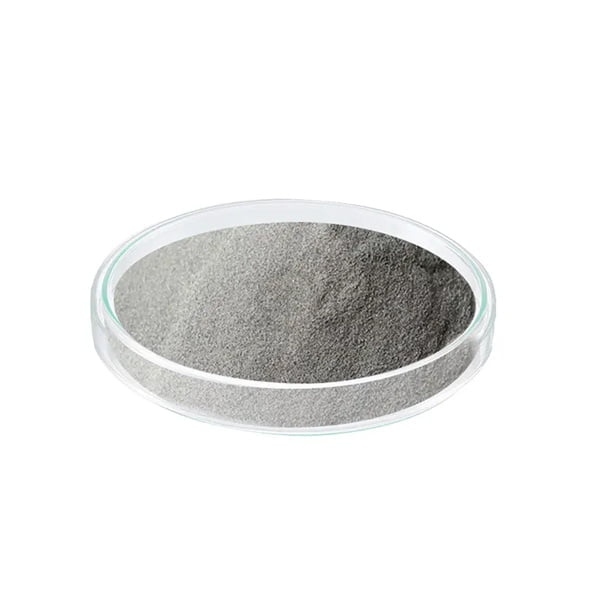
VANLIGA FRÅGOR
Här följer några vanliga frågor om MIM-metallpulver:
| Fråga | Svar |
|---|---|
| Vilka är fördelarna med att använda MIM-metallpulver jämfört med traditionella bearbetningsmetoder? | MIM erbjuder designfrihet, hög precision, massproduktionskapacitet och mångsidiga materialval, ofta med mindre materialspill. |
| Vilka är begränsningarna med MIM-metallpulver? | Begränsningar i detaljstorlek, potentiellt lägre mekaniska egenskaper jämfört med vissa traditionella metoder, överväganden om ytfinish och designbegränsningar för framgångsrik MIM-produktion. |
| Vilka faktorer påverkar valet av MIM-metallpulver? | Egenskaper, tillgänglighet, kostnad, miljöbestämmelser och önskad tillämpning är alla avgörande faktorer. |
| Hur mycket kostar MIM-metallpulver? | Priserna kan variera avsevärt beroende på material, pulveregenskaper, volym och leverantör. |
| Vilka är framtidsutsikterna för MIM-metallpulver? | Framtiden är lovande när det gäller utveckling av nya material, förbättrade pulveregenskaper och potentiellt lägre kostnader. |
Genom att förstå de komplicerade egenskaperna hos MIM-metallpulver kan du utnyttja deras unika egenskaper för att skapa innovativa och funktionella metallkomponenter. Med ständiga framsteg inom materialvetenskap och tillverkningsteknik kommer MIM-tekniken att spela en allt viktigare roll när det gäller att forma framtiden för metalltillverkning.
Dela på
MET3DP Technology Co, LTD är en ledande leverantör av lösningar för additiv tillverkning med huvudkontor i Qingdao, Kina. Vårt företag är specialiserat på 3D-utskriftsutrustning och högpresterande metallpulver för industriella tillämpningar.
Förfrågan för att få bästa pris och anpassad lösning för ditt företag!
Relaterade artiklar
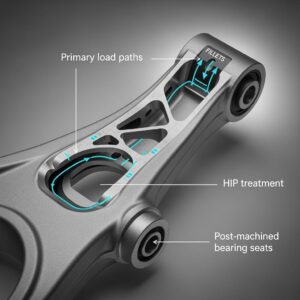
Metal 3D Printing for U.S. Automotive Lightweight Structural Brackets and Suspension Components
Läs mer "Om Met3DP
Senaste uppdateringen
Vår produkt
KONTAKTA OSS
Har du några frågor? Skicka oss meddelande nu! Vi kommer att betjäna din begäran med ett helt team efter att ha fått ditt meddelande.







